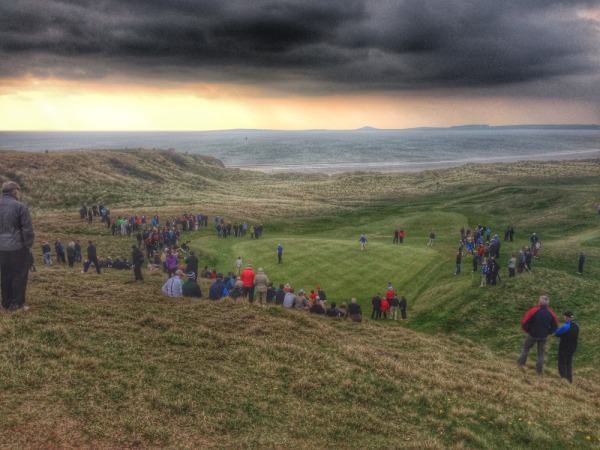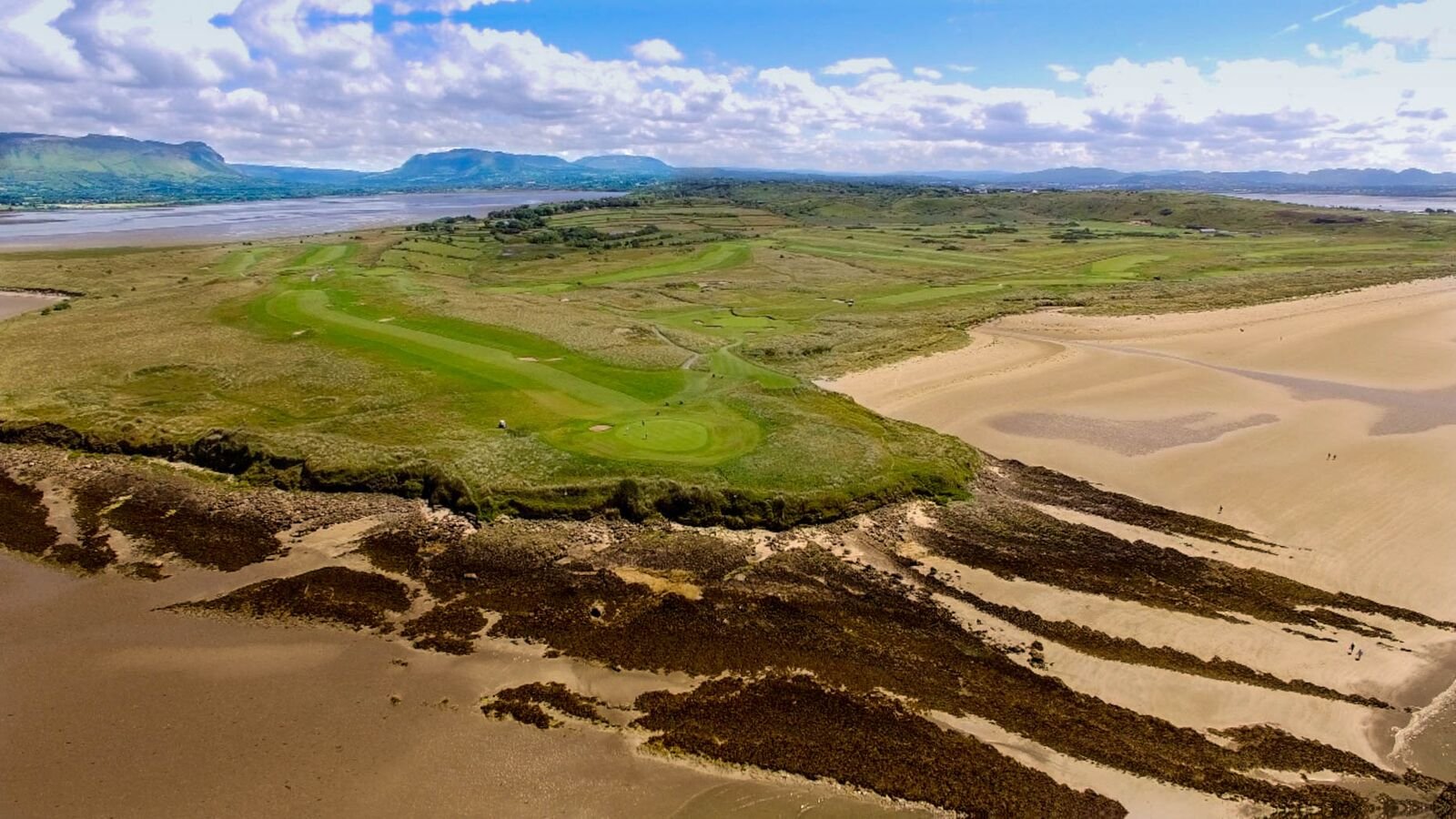Rosses Point 2.0 — Restoring a masterpiece

The 17th at Rosses Point. Plans to enhance the hole have yet to be revealed but a new pin position on the back right would certainly be viable.
Pat Ruddy has a love and a reverence for County Sligo and Harry Colt's classic links. But rather than fearing change, he believes it's crucial that one of his first great golfing loves is given the makeover it needs to remain a viable, living theatre of golfing dreams and not just a museum piece.
Restoring shot values from 1927 in an era when low handicap amateurs now blast the ball more than 300 yards is crucial to the integrity of the traditional home of the West of Ireland Championship.
County Sligo members are rightly proud of their course. But they also that it must be able to pay for itself and a well-executed modernisation will bring it in line with the other traditional links powerhouses of Irish golf, all of which have made major improvements in recent years.
That will lead to more visitors and more resources in an age when cash is in short supply for such projects. With Royal Portrush ready to embark on the creation of two new holes as they prepare to return to the Open Championship rota — they've hired Co Sligo's head greenkeeper — exciting times lie
Commercial difficulties or even staging problems might make it difficult for the Irish Open to be staged under Ben Bulben's silent gaze for the first time. But that will hardly matter if Rosses Point as long as once again mentioned in the same hushed tones of reverence reserved for the other giants on Irish golf's Mount Rushmore.
"Sligo had the job done in 1927 and because there not as many golf courses then, it was definitely amongst the elite courses in the world," Mr Ruddy explained. "Shortly after that, in the early 1930s, along came Cecil Ewing and he would have attracted people to play in the Championship and to come socially.
"County Sligo became one of the homes of championship golf in Ireland along with Portrush and Newcastle, Dollymount, Portmarnock and Lahinch. They were the main venues for the championships, the Close, the Home Internationals and anything else that came along.
"And that’s where all the championships were played until the 1960s. Rosses Point was at the very dead centre of the universe in golf. But the wheels of world golf have been turning rapidly in the last two or three decades, as we all know. And so any place that didn’t do what they did at Lahinch or Portmarnock and Royal Dublin, if they don’t make efforts to improve, they can become slightly dated.
"What we want to do is bring County Sligo back into the centre field position with the changes aimed much more on the skilled golf level... It's very exciting and one hopes that the masterpiece will be good for centuries to come."
County Sligo Golf Club, Championship Links.
Phase One course changes explained by golf architect Pat Ruddy
The Championship tee at the first will move left
- 1st hole — Par 4. We'll take the championship tee and flip it over its own width to the left. Instead of hitting down the middle, you will almost be standing on the left edge of the fairway. A bit more skill will be required and a mound will be introduced down the left. The first green will be extended to the right to create a pin position behind the right hand bunker, which is basically out of play as it is.
- 2nd — Par 4. The most significant change will be to bring the out-of-bounds wall more into focus for the big hitters and create a much larger green. There will also be a new fairway bunker on the left with the green extended to the right.
- 3rd — Par 5. A new green will be built back and left, near the little house, extending the hole by more than 65 yards.
- 4th — Par 3. Untouched.
The view from the current championship tee at the fifth. The new tee will be considerably further right with the drain realigned, parallel to the line off the tee.
- 5th — Par 5. A new championship tee will be built. It is a straight beat up the middle at the moment. So you will exit green four to the right rather than the left and go up onto the slope so it will become a dogleg right. The stream will then be realigned parallel to the shot and the dogleg will be strengthened and it will become a strong driving hole with 30 yards added onto the drive. So it is not a straight beat up the field anymore.
Pitching to the seventh.
- 6th hole — Par 4. There used to be a big bunker on the left near the 300-yard mark. That was backfilled at some stage and a nice valley was created. We are going to accentuate that valley out from the left to the edge of the fairway and put two bunkers into the valley. That;s just to leave a 32-33 yard fairway to the right as far as the little cutting. Players in the West were knocking it up the left with impunity. So this will say hello to that sort of man. It’s a great hole. A very simple hole and it takes its victims quite nicely. So it’s just to tighten the tee shot slightly for the champion more than for the club golfer. The sixth green we are not touching it, it’s a clever green. Just as we are not touching the fourth green, another clever green, or any of the par-threes.
- 7th — Par 4. We will stretch the green to the right so there will be more pins going up along the stream. So it is taking a couple of steps to the right and the left edge will come in a little bit. There will be a pin out there were the little shed is on the right. As far out as that. As for the tee shot. They are battering the ball up the fairway there so there is another fairway bunker happening up on the right because they are banging the ball past the existing bunkers with gay abandon. I am trying to look at a surprise there. The stream that comes around the green comes down left of the fairway and hasn’t been noticed by people very much. Players trying to avoid the new bunker on the right will be looking left so we will turn the bunker on the left into a centre of the fairway bunker and cut some fairway to the left. If you go left trying to get at the pin that is going further right, it will bring the stream into play off the tee.
- 8th — Par 4. The move of the seventh green to the right opens up a little bit of space to move the eighth tee back another 30 yards or so. The eighth green will not touched except for a greenside bunker.
- 9th — Untouched
The 10th tee. A new Championship tee will be nearly 80 yards further back.
- 10th — Par 4. A very significant change. At the moment it’s a beautiful, beautiful beautiful hole. One of most beautiful in golf. But driving the ball, even club members are beating the ball down into the dip just in front of the green. So the terrance on the fairway and the bunker, one of the most beautiful bunkers in Irish golf, a beautifully shaped and wild looking bunker, is totally out of play. So by slipping a new championship tee in about 80 yards further back, everything will change depending on the weather. The green will be extended out the back by 35 yards. The hole will become a much more interesting hole altogether.
- 11th — Par 4. The green is a classic and won't touched. But we will move the championship tee back 30 yards and to the right, behind the new extension to the 10th green. It will make it a left to right bender more than a dogleg right with a bunker up in the fairway on the left. It is not that tough on the drive but it is a little bit longer and it will kill the ball coming into the hill instead of it running up the hole. The whole purpose there is to retain the shot value on the second shot, which is one of the great second shots in golf — a mid to long iron rather than an eight iron. When the pin is out on the right edge of the green, it’s one of the great testing shots of golf. Just adding these extra 30 yards to the drive plus the extra few yards for the ball dying on the hill rather than running like hell, you will have 35 yards extra on the second shot or thereabouts and that will restore the shot values that were there when it was built with the danger of a shot going into the dip when the pin is on the right.
The new 11th tee will be left of the hut as we look at this picture.
- 12th — Par 5. Apart from the members' tee, which will change because of danger to the ninth, the changes are mainly to the fairway and right of the green. It will be bunkered up the left. Watching the West this year, they were landing 290 yards down the left, halfway between the bunker on the left and the one near the green. So the fairway will be aligned further right by about 20 yards and it will be bunkered down the left with one "hello" bunker on the right of the fairway. The little valley or dip to the right of the green will be extended inwards to the edge of the green so that the right hand half of the green will be pin-able behind the bunker. The left half will be left open to the running ball.
- 13th — Par 3. Unchanged.
- [14th-15th-17th, all Par 4] — Proposed changes to these holes will be made in Phase Two.. [Writer's note — watch this space for details]
- 18th — Par 4. The green will be extended a little bit back and left with a bunker on the left to create a championship pin position there. It’s a great hole, though it has become short, by virtue of the fact that championships are decided there. It is always a nervous, tense situation so it is just to emphasise the nervousness factor by creating a pin position back left with a bunker guarding it. But the green will remain as it is otherwise.
With a new pin position behind a new bunker back left, the 18th will be a true nerve-jangler.





